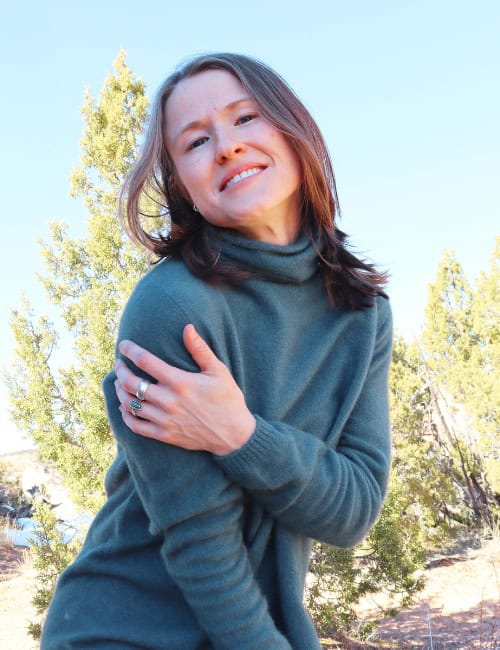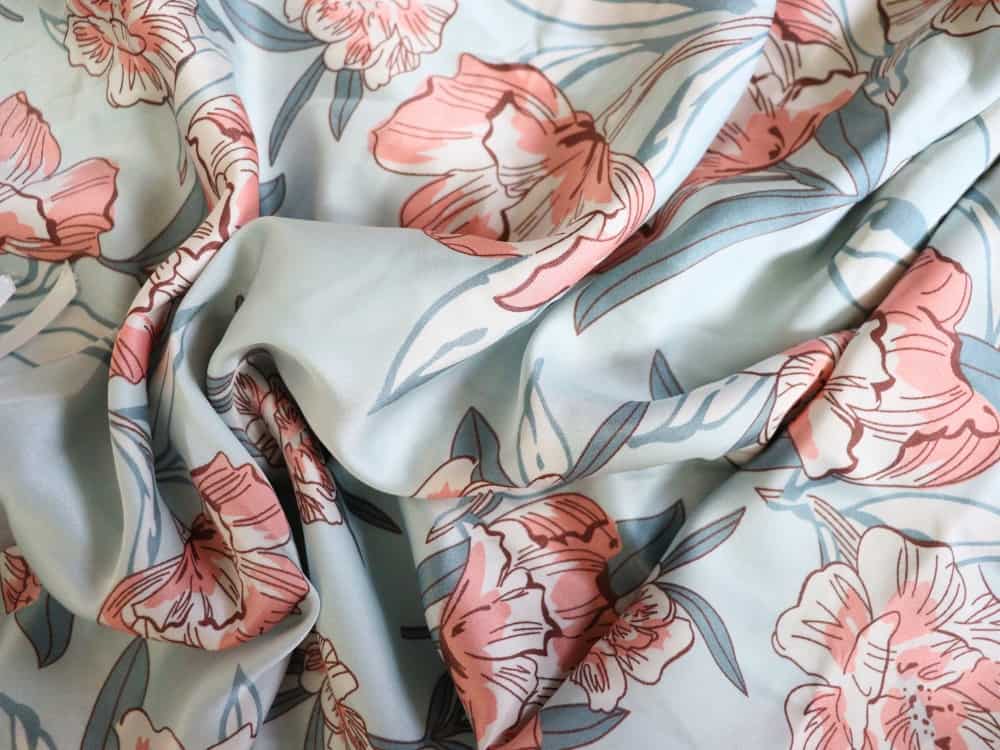
Ahimsa Silk: Is “Peace Silk” Really Peaceful?
As planet-friendly fashionistas, we’ve been trying on various sustainable fabrics.
From animal-derived fabrics like ethical wool and ethical cashmere to semi-synthetic vegan fabrics like lyocell and bamboo, we’ve discovered that ethics and sustainability are rarely black and white.
Suffice it to say there’s a lot of greenwashing going on in the sustainable fashion world.
Conventional silk production (or sericulture) is anything but soft and shimmery—especially for the billions of silkworms killed inside their cocoons.
But is Ahimsa silk, also known as “peace silk,” an ethical alternative, or is someone pulling the wool (silk?) over our eyes?
Let’s unravel the answer.
The Full List Of Ahimsa Silk Fabric Ethical Considerations
1. What Is Peace Silk (or Ahimsa Silk)?
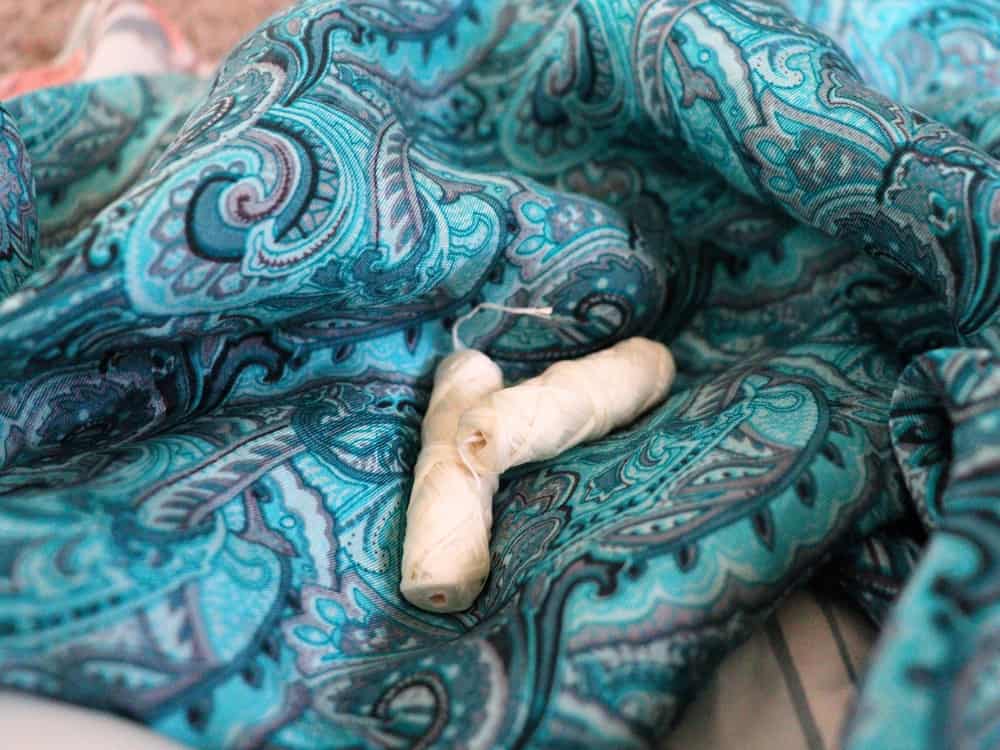
Peace silk is also known as Ahimsa silk, from the Sanskrit word “ahimsa,” meaning nonviolence.
To understand peace silk, we need to compare it to conventional silk, an animal-derived fabric made from the cocoon filaments of domesticated silkworms (which are actually moth caterpillars).
Several species of moths are used to produce silk, the most common being the Bombyx mori moth, also known as the “mulberry silkworm” because it feeds exclusively on mulberry leaves.
Traditionally, harvesting these cocoon filaments involves boiling the silkworm while it’s still alive. This makes extracting and collecting the silk fibers easier, but it also means a very cruel and painful ending for the caterpillar.
Alternatively, Ahimsa silk allows the silkworm to mature into a moth and leave the cocoon before it is processed.
In other words, Ahimsa peace silk fabric doesn’t involve killing silkworms. Sounds good, right?
Unfortunately, it isn’t as simple as that, and Ahimsa silk isn’t necessarily any kinder to the Bombyx moth than regular silk.
To understand why Ahimsa silk is not the ethical silk we’re led to believe, we need to look at the production process in more detail.
2. Ahimsa Silk Production
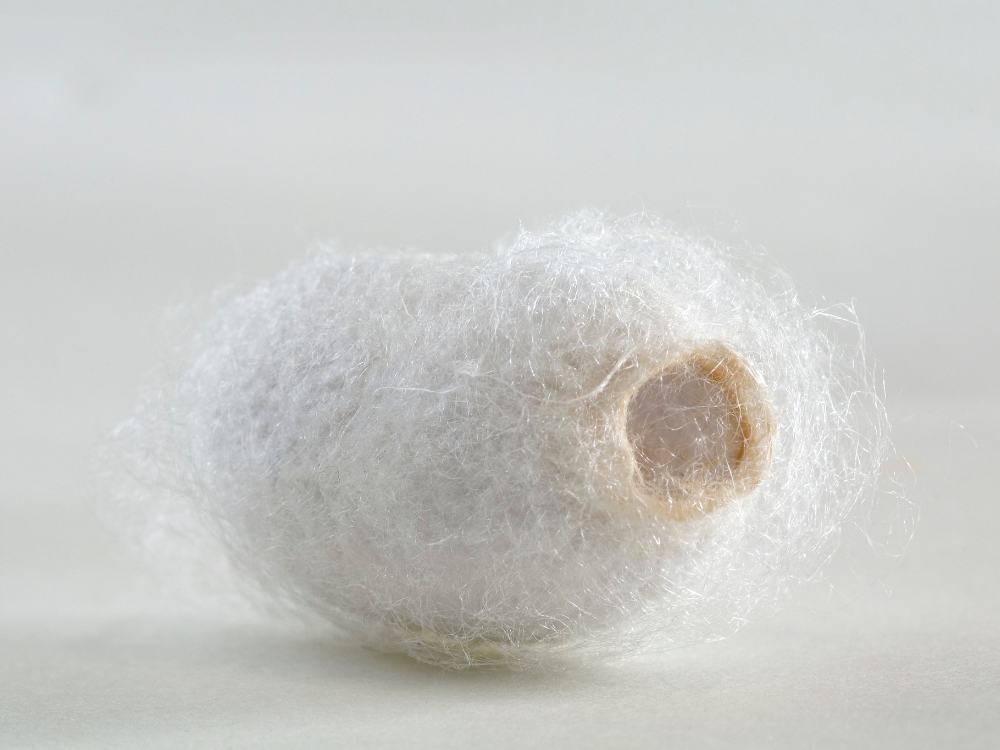
Ahimsa silk production generally starts the same way as conventional mulberry silk production.
- Eggs from previous mature silk moths are incubated in a temperature and humidity-controlled environment.
- The domesticated silkworms hatch, are transferred to “rearing trays”, and are fed mulberry leaves for about 30 days (hence another commonly used name, “mulberry silk”).
- The silkworms are transferred to mountages, special frames where the cocoon spinning will take place.
- This process lasts about a week, during which time a cocoon of silk, made from a single long silk fiber spanning up to 1.6 kilometers in length, is produced. Around 3,000 silkworms are required to make a pound of silk.
What happens next differs depending on the silk manufacturer, but the most common practice is to steam or boil the cocoons to kill the pupae inside.
If this didn’t occur, the adult silk moths would emerge from their cocoon, breaking the single strand of silk fiber, which is undesirable for silk production.
The Ahimsa silk process allows the moth to leave the cocoon before it is processed. This results in several disconnected strands of silk, which create a rougher fabric. Because the process is more difficult and time-consuming, Ahimsa silk fabric is usually more expensive.
On the surface, Ahimsa silk production appears to be a much better deal for the silkworms. However, look a little closer, and it’s not so shiny.
3. Disadvantages Of Ahimsa Silk
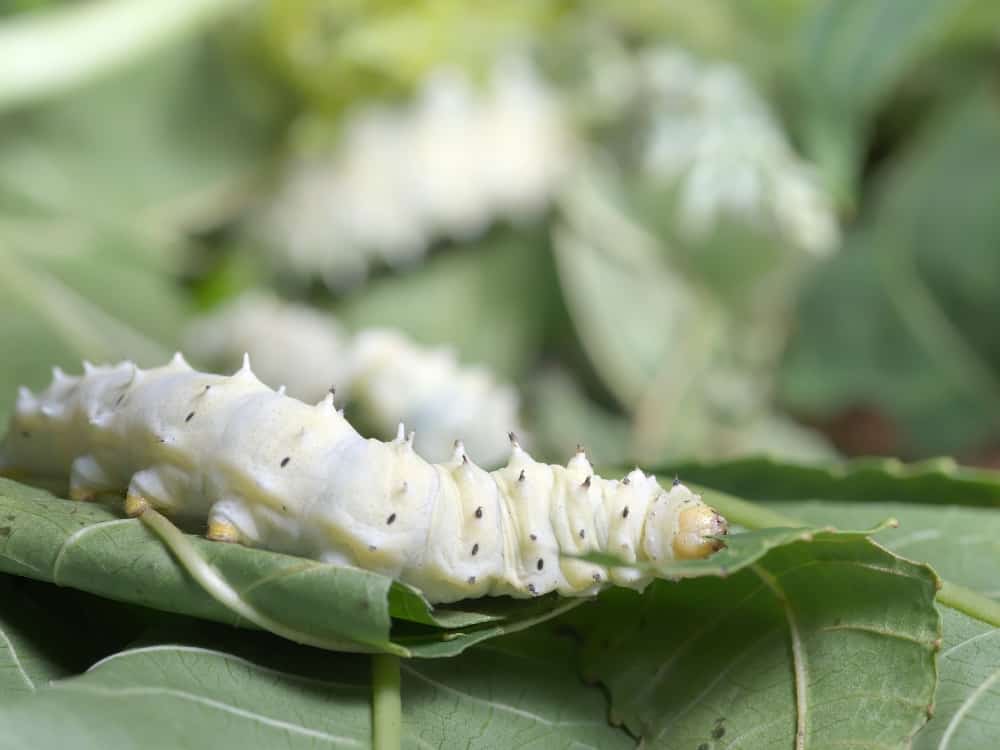
Animal Welfare
Using an animal to satisfy any human-oriented goal always has some ethical concerns.
Silk is no exception.
The Bombyx mori moth no longer exists in the wild. Over the years, its ability to fly, see, or respond appropriately to predators has been bred out.
Conventional silk production involves the death of billions of silkworms, and even in the case of Ahimsa silk, when the moths are allowed to emerge from their cocoons, the adult Bombyx mori moths may be killed after mating.
Beauty Without Cruelty India investigated Ahimsa silk production and found that in one facility, once the female moths had laid their eggs, they were crushed and checked under a microscope for diseases. If diseases were found, then all of the eggs would be destroyed.
Male moths were refrigerated and repeatedly bought out to mate before being discarded.
Moreover, a large number of caterpillars will starve to death.
Each female moth lays an average of 500 eggs. Not all of the eggs are required for the next round of silk production, and if the hatched caterpillars are not fed, they will die.
It appears that Ahimsa silk is not the cruelty-free silk we’re led to believe it is and really isn’t much better than conventional mulberry silk production.
Eri Silk & Tussah Silk
You may have come across other types of silk being referred to as “peace silk,” namely Eri silk (from the Samia ricini moth) and Tussar silk (from the Antheraea genus).
Like the mulberry silk moth, the Eri silk moth is fully domesticated. It is commonly claimed that Eri silk is “peace silk” because the caterpillar creates the cocoon with an opening at one end, allowing the moth to leave before the cocoon is processed.
However, farmers sometimes cut the cocoons open, and even when allowed to exit naturally, the issue of “excess” caterpillars starving to death remains.
Tussah silk is what’s sometimes referred to as “wild peace silk.” While an appealing name, again, misinformation abounds.
Tussah silkworms are raised outside on trees, but it is unclear whether the moths are allowed to vacate their cocoons. Certainly, there are sources that point to the majority of cocoons being killed.
It also appears there may be some greenwashing with the term “wild silk”.
Some peace silk clothing brands portray these cocoons as being wild-harvested from the forest, but in reality, these moths are being farmed, albeit outside on tree plantations instead of indoors.
While they may lead a somewhat more natural life than those raised indoors, the exact farming and production methods are unclear and differ between different silk farmers.
And animal welfare is not the only ethical issue to consider.
Unethical Labor Practices
Silk production is a labor-intensive process associated with various negative impacts for farmers and silk reelers.
The majority of silk production takes place in China, India, and Uzbekistan, where there are concerns about low wages and human rights abuses.
There have been multiple reports of child and forced labor as well as injuries, including burns and other health issues resulting from unsafe working conditions and exposure to the chemicals used during silk production.
Mulberry farmers (who grow the leaves on which the silkworms feed) also experience health problems resulting from pesticides and herbicide use.
Silk production can generate important income, especially for rural communities. However, it is essential to find out what checks a brand has in place to ensure that the workers in its supply chain receive fair wages and have safe working conditions.
Third-party certifications, including Fairtrade, help ensure responsible sourcing.
Energy, Water, & Chemical Use
Silk production is resource-intensive.
On the Higg Materials Sustainability Index (MSI) silk is one of the highest-ranking fibers in terms of environmental impact, primarily due to GHG emissions from production.
Silk production involves high water and energy use in maintaining the correct temperature for silkworm rearing and processing the cocoons into fabric.
Then, there is the chemical usage. Producers sometimes use hormone disruptors, like the insecticide methoprene, to lengthen the cocoon-making time and yield more silk.
Further chemicals are used to soften and bleach the silk fiber.
Metallic salts are still sometimes used for fabric weighting and then there is the dyeing process, which usually involves more chemicals.
It is also important to consider the farming practices used to grow the mulberry leaves. While it is possible to grow mulberry trees organically, cultivation often involves agrochemicals, including fungicides, herbicides, and pesticides.
These chemicals pose a hazard to workers in the supply chain and are released in wastewater (or irrigation run-off), polluting the environment and harming wildlife. They also affect silk’s biodegradability.
What About Organic Silk?
The organic production of silk is free of fertilizers and pesticides, and the water used during fabric processing is free of heavy metals and toxic chemicals.
However, just because it’s a more eco-friendly silk doesn’t mean it’s ethical.
For all the reasons we’ve discussed above and the fact that no certifications exist for “peace silk”, we recommend avoiding buying virgin silk fabric altogether.
4. Recycled, Deadstock, & Secondhand Silk

Before you completely throw the towel in on ethical silk, there may still be a couple of options.
You may be able to find garments made from recycled or reclaimed silk. Recycled silk fabric can be made from silk industry waste, including cocoon waste, or recycled silk garments, including used saris.
Look for Global Recycle Standard (GRS) certified fabric that verifies genuine recycled content as well as responsible production.
Note, however, that different dyeing processes can be used with recycled silk, so check with the brand that only non-toxic, sustainable dyes have been used.
Deadstock silk is leftover silk fabric or remnant fabric sourced from design houses, garment manufacturers, or textile factories. Using waste fabric that would otherwise end up in landfill presents a more sustainable option.
Some of our favorite upcycled fashion brands use deadstock fabric and upcycled silk from secondhand clothing like men’s ties.
You can also avoid virgin silk by shopping secondhand and picking up a pre-loved silky bargain from your local thrift store or one of the many online second hand stores.
It’s important to note that none of the above are vegan—they’re still animal products. Whether you’re happy to wear recycled, upcycled, deadstock, or secondhand silk is a matter of individual ethics.
If you’d rather not wear silk at all, but still want to include something smoothe in your wardrobe, there are an increasing number of vegan-friendly alternatives to silk that are also produced sustainably.
5. Vegan Alternatives To Silk

Fortunately, for those of us who don’t like wearing animals or their products, dressing in a silky-smooth way is still possible.
Vegan alternatives to peace silk include:
- TENCEL™ lyocell: A sustainably produced semi-synthetic fabric that’s breathable and moisture-wicking. Wood from sustainably sourced eucalyptus trees is processed using a closed-loop system that recycles 99% of the organic solvent.
- Bamboo fabric: Not all bamboo fabric is sustainable, but bamboo lyocell gets our thumbs up. Ettitude’s CleanBamboo®, for example, is an OEKO-TEX-certified bamboo lyocell used for sustainable towels and silky-soft bedding.
- TENCEL™ modal: Like bamboo, not all modal fabric is sustainable due to the chemicals used in production. TENCEL™ modal, however, is created with some of the highest environmental standards.
- Cupro fabric: Created as a vegan alternative to silk, cupro is a semi-synthetic fabric made from cotton waste. While not always produced sustainably, it can (like bamboo and modal) be made using a closed-loop process.
- Recycled Sateen: Virgin synthetic fabrics are a no-go, but many sustainable brands now use reclaimed synthetics like recycled polyester, which can look super silky.
- Innovative fabrics: New fabric innovations include Orange Fiber’s vegan silk alternative made from citrus waste and Bolt Thread’s Microsilk, inspired by spider silk and developed using a bioengineering and fermentation process. Similarly, brands like Maylyn & Co offer Persian Lotus silk ™ made of organically-farmed lotus fibers and recycled polyester.
Did you know we Have a Newsletter?
We cover the latest in sustainable living, fashion, zero waste, beauty, travel, finance and more…
Final Thoughts On Ahimsa Peace Silk
So, will we be sleeping peacefully in Ahimsa silk, or will we need to look elsewhere for our ethical pajamas and sustainable bedding?
Sadly, Ahimsa silk isn’t the peaceful, ethical fiber it’s often claimed to be.
Due to multiple concerns about animal welfare, worker welfare, sustainability, and transparency, we recommend avoiding virgin silk and opting for recycled or vegan silk instead.
Now it’s time to pass the peace stick and (hopefully) cause a metamorphosis in someone’s silk-buying tendencies.
Pin these:




